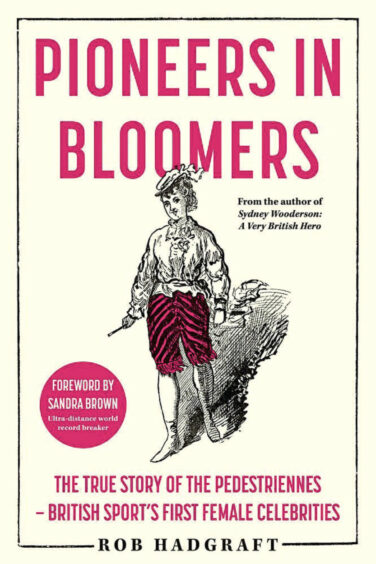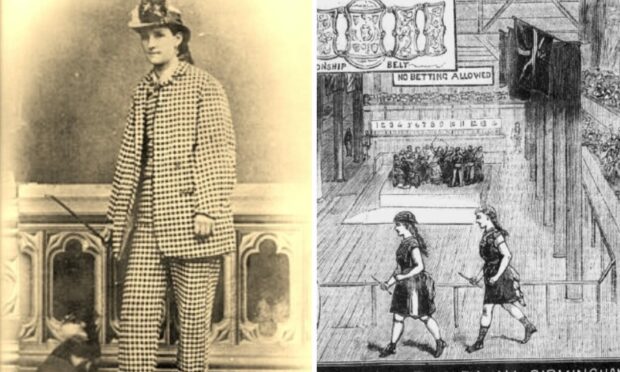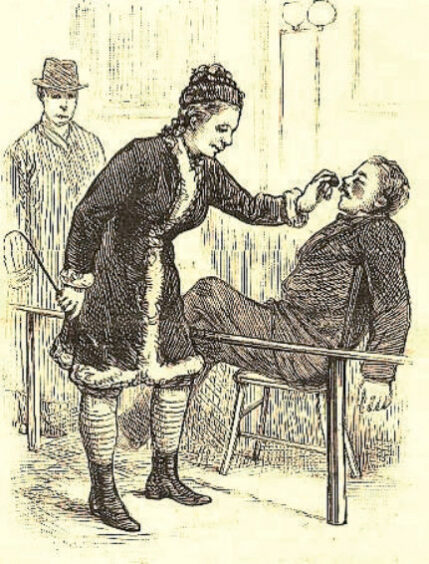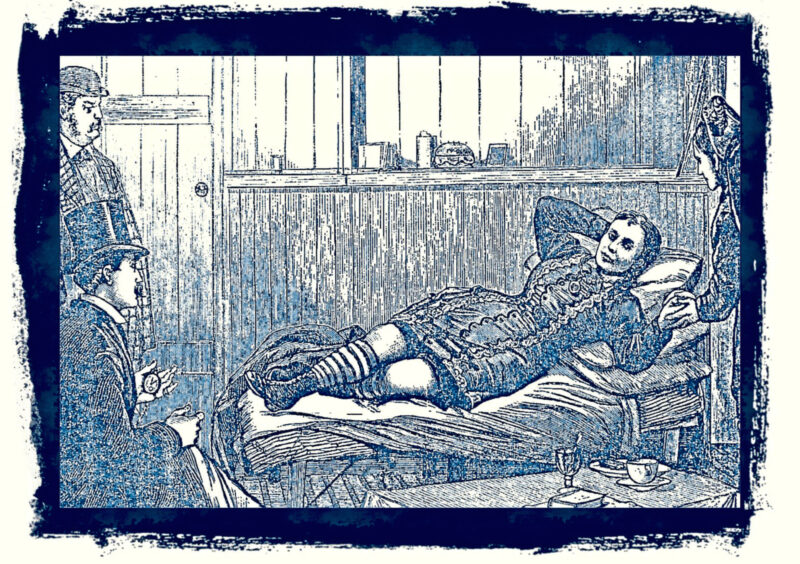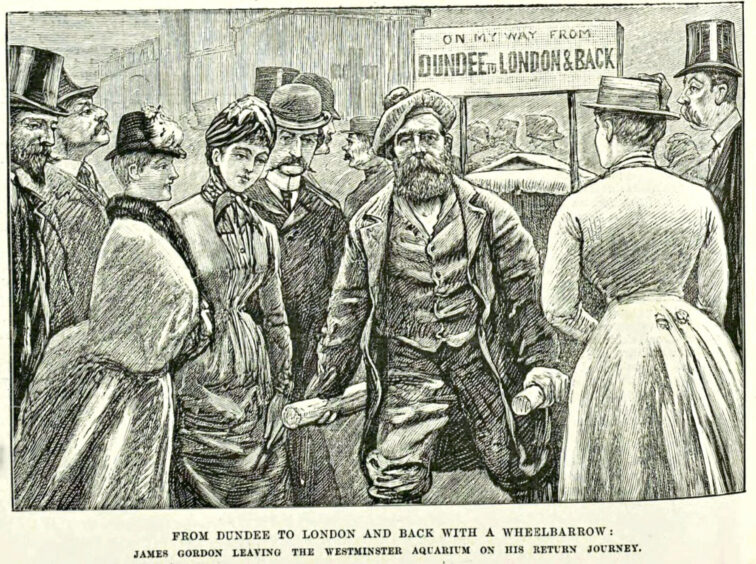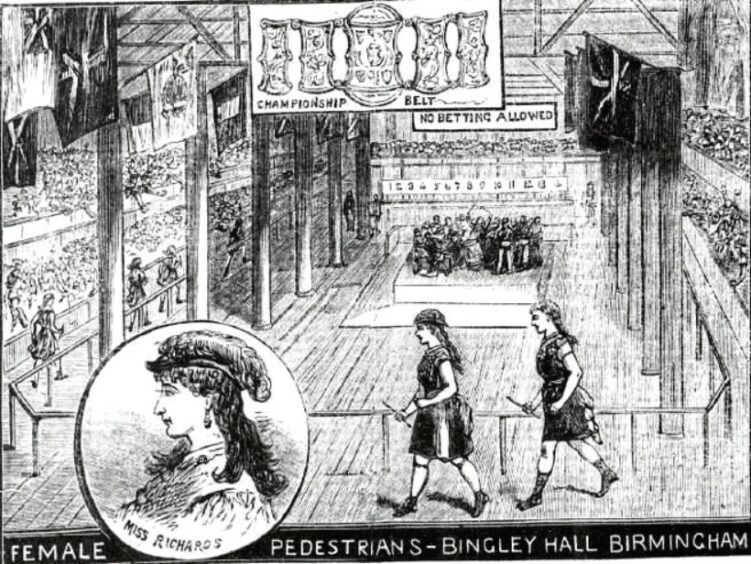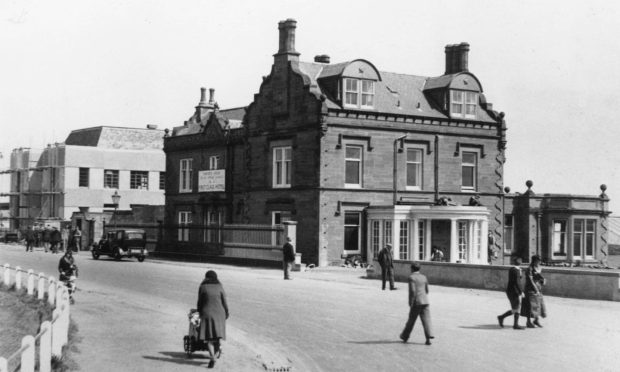A new book shines a spotlight on ‘pedestriennes’ – competitive female walkers, often derided and assaulted, as they took part in the late 19th-Century sport.
They walked mile after mile, day after day – often completely alone and frequently dressed in ‘bloomers’ – to entertain the public and earn money to feed their families.
The working-class women who took part in professional ‘pedestrianism’ often found themselves derided, denounced and even assaulted.
But some stuck at it and emerged as strong, courageous and talented characters.
Inspired by their bravery, author Rob Hadgraft delved deep into the forgotten world of professional female pedestrianism, a pursuit largely confined to the second half of the 19th Century.
Ultimately, he concludes that these pioneering Victoria-era ladies laid the foundations for modern women to take part in competitive sport.
Pioneers in Bloomers
Rob’s book, Pioneers in Bloomers: The True Story of the Pedestriennes – British Sport’s First Female Celebrities, tells the stories of the women who, in spite of barriers and prejudice, achieved prominence, becoming the largely unsung trailblazers of women’s sport.
He explores the lives and “remarkable adventures” of 21 women, including several from Dundee, Perth, Crieff and Aberdeen.
“Dozens of these working-class women abandoned humdrum lives to become history’s first professional sportswomen,” reflects North Essex-based Rob.
“They bravely put personal safety and decorum aside to tackle astonishing walking contests of 1,000 miles or more, competing against each other or against the clock, chasing cash prizes to feed and clothe their families.”
Shocked by their audacity
Victorian society was shocked by their audacity. A handful became rich and famous, but many had a torrid time.
Massive crowds showed up to watch them trek endlessly, often into the wee small hours. While the public loved them, the authorities wanted them banned.
“The walks were often riotous affairs that attracted gamblers, drinkers and rowdy behaviour, but it was the women themselves who would be lambasted in the press, condemned as immoral and despicable,” says Rob.
“The controversy only intensified when they adopted the daring new ‘bloomers’ costume from America.
“This proved far more practical for walking, running or cycling than the billowing skirts women of the day were expected to wear.
“They had to defy critics who were convinced women in bloomers were deliberately attempting to break down social distinctions by donning these trouser-like garments.”
Discouraged
It must be discouraged, exclaimed The Dundee Courier of the day, which stated: “Why should ladies quarrel with their petticoats?”
The paper suggested a cunning plan was afoot to assert the rights of women by allowing them to “wear the breeches” in relationships and in society.
While the public loved them, the authorities wanted them banned.”
Research
Rob, who spent 26 years as a regional newspaper journalist before turning freelance to research and write about sporting history, was inspired to pen his new book after a “historian acquaintance” suggested he check out the life of “Madame Angelo” – a woman who achieved huge success in pedestrianism in Victorian times, overcoming barriers including being female and of mixed race.
“After delving back into this fascinating and forgotten world I decided to write a book about 21 or so of the British women who, like Madame Angelo, became known as ‘the pedestriennes’ and had some remarkable adventures,” he says,
“In 2023 with women’s professional sport now flourishing in the UK it seemed time we celebrated these brave pioneers of 150 years ago who paved the way and laid foundations for modern women to take up sport for a living.”
Dying sport
Towards the end of the 19th Century, pedestrianism was dying in Britain, says Rob, overtaken by properly-regulated pursuits like football and amateur athletics.
However, there was a sudden and unexpected renaissance in Scotland in 1886 in the shape of women’s six-day racing.
“By now men had largely abandoned multi-day foot-racing events, and the remarkable resurgence north of the border was almost entirely driven by women.
“There would be seven female-only walking tournaments in the UK that year – four in Aberdeen, two in Dundee and one in Glasgow.
“They pulled in big crowds and six leading professionals, starved of opportunities down south, came from England to join the action.”
Walking contests
In February 1886 John Gibb, keeper of the Bon Accord Recreation Hall in Aberdeen’s Market Street, offered a bumper £60 in prize money (equivalent to around £10,000 today) at a 16-hour women’s walking contest spread over six days, involving two or three hours of action per night.
He recruited a handful of “London ladies” – well known names in the sport – who arrived looking bedraggled after suffering sea-sickness on the 36-hour journey by boat.
Around 5,000 people packed around the hall’s wooden indoor track defying earlier suggestions in the press that such a spectacle would “shock the propriety of an Aberdeen audience”.
Rob says: “The partisan crowd enjoyed the sight of local women Lizzie Reith and ‘Miss Lorimer’ beating four experienced southerners in the week-long contest.
“Reith pipped Lorimer by a matter of inches in a rip-roaring finish that thrilled the noisy onlookers.”
Dundee in on the action
Three weeks later Dundee got a slice of the action. The city put on an event on similar lines, using the tiny 42-yards-per-lap Newsome’s Circus track which was at that point based in the Craig Pier area of Dundee.
“Admission was one shilling for a reserved seat, or sixpence on the night,” says Rob.
“Dundonians lapped it up and turned up in their thousands. With a live orchestra providing the soundtrack, the crowds enthusiastically roared Miss Lorimer to victory. She picked up the £20 first prize (£3,300 in today’s money) ahead of Londoner ‘Madame Lucelle’.”
Aberdeen antics
Returning to Aberdeen for a 14-hour event in May, the southerners were again up against locals Miss Lorimer and Miss Reith.
Accomplished English walkers Kate Brown and Madame Englo also took part, but it was the Aberdeen girls who enjoyed an extraordinary triumph, scooping the £60 prize money between them, led by Miss Jeffrey who tramped for 83 miles in 16 hours.
Claustrophobic
Rob says the indoor events were “not for the squeamish”.
“They were not in the large meeting halls or gymnasiums some of the competitors were used to, but on tight and claustrophobic temporary wooden tracks. It meant multi-lap walking made the task psychologically difficult as well as physically.
“An earlier event at Perth’s Drill Hall involved a track of just 40 yards circumference, which led to frayed tempers, and at least three performers coming to blows and being disqualified.”
The fact the women had made money from simply walking long distances inevitably attracted the attention of non-sporting types desperate for cash to survive.
Wheelbarrow pushers
Two Dundee men, James Gordon and John Cochrane, were examples of a number of destitute Scotsmen who set off for London pushing wheelbarrows, in a bid to earn sympathy and donations en-route.
A Mrs Adams attempted the same thing, also aiming for the English capital, 450 miles from her home in Crieff.
She was soon followed by mother-of-four Mrs McGowan from Perth, whose husband was out of work. She decided to push a pram to London containing her eight-month-old baby.
Unsympathetic
The press at the time was largely unsympathetic: “It is high time this sort of nonsense was ended,” declared The Courier.
One of the “top” performers proved to be Aberdonian Margaret McPhee, under the stage name ‘Miss Lorimer’, says Rob.
Margaret was married with young children, and participating in the sport caused strife at home.
Assault
“In early 1886 her husband was arrested for allegedly attacking her after they argued about walking taking precedence over her domestic responsibilities,” says Rob.
“The Aberdeen Weekly Journal said this episode should be a warning to any women thinking of giving pedestrianism a try.
“When the McPhees appeared in court at Aberdeen, the magistrates heard that husband William was a scavenger (street cleaner) who had attacked his wife at their Seamount Place home. She was described as a former fishwife who had found fame as a female pedestrian.
“The day after her victory in the 16-hour walking tournament in Dundee, Margaret was exhausted and recovering in bed.
“William knelt on her chest and grabbed her by the throat saying he would ensure she never became tired again by killing her.
“The children began to scream and the police were called and took him away. He was found guilty of assault and fined 10s 6d with the alternative of five days in prison.”
Popularity faded
With Victorian six-day endurance events such as swimming and cycle racing emerging around the end of the 19th Century, the popularity of pedestrianism began to fade.
“However the series of women’s races in Aberdeen and Dundee in 1886 kept the flame burning a little longer and provided some memorable entertainment for thousands,” says Rob.
“The bold pioneers such as Miss Jeffrey and Miss Lorimer would in time prove to be the ground-breaking Victorian predecessors of this region’s female sporting superstars – the likes of Liz and Eilish McColgan, Kirsty Muir and Sinead Kerr to name but three.”
